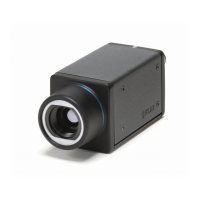About I/O, synchronization, and measurement
10
Figure 10.1 Master/slave synchronization between two FLIR Ax5 cameras (NTSC).
NOTE
External synchronization can be applied but only by using an input signal with a frequency of 29.97 Hz
(NTSC).
• The signal voltage (relative to digital GND) is 3.3 V.
• The pulse width (minimum) is 100 ns (will be extended to 1 μs).
Note that the synchronization mode is not persistent. The camera will always return to
SyncMode Disabled after reset or power cycling.
For slow configurations (9 Hz), the output frame rate is a fraction of the sync pulse rate.
Because there is ambiguity as to which received pulse triggers the frame timing, FLIR
does not recommend using the external sync interface with a slow-configured camera.
NOTE
The only difference between ExtSyncMaster and SelfSyncSlave mode is that the incoming sync signal is
relayed to the SYNC_OUT port if set to ExtSyncMaster.
10.3 FLIR Ax5 measurement
The FLIR Ax5 camera has an option to output 14-bit digital video that is temperature linear.
Each count in the temperature-linear video corresponds to either 0.04 K or 0.4 K in 14-bit
video, depending on the selected resolution.
Temperature-linear output is enabled or disabled with the feature register:
TemperatureLinearMode: On (1) or Off (0)
Temparture-linear resolution is determined with the feature register:
TemperatureLinearResolution: Low 0.4 K (0) or High 0.04 K (1)
If TemperatureLinearMode is On, the signal-to-temperature mapping is calculated using
the equations
S corresponds to the 14-bit pixel value.
#T559770; r. AF/30726/30726; en-US
17

